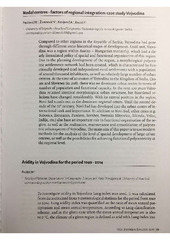Приказ основних података о документу
Nodal centres – factors of regional integration: case study Vojvodina
| dc.creator | Pavlović, Mila | |
| dc.creator | Živanović, Vedran | |
| dc.creator | Kovjanić, Aleksandar | |
| dc.creator | Krstić, Filip | |
| dc.date.accessioned | 2023-04-21T11:41:09Z | |
| dc.date.available | 2023-04-21T11:41:09Z | |
| dc.date.issued | 2019 | |
| dc.identifier.isbn | 978-86-7031-507-5 | |
| dc.identifier.uri | http://gery.gef.bg.ac.rs/handle/123456789/1265 | |
| dc.description.abstract | Compared to other regions in the Republic of Serbia, Vojvodina had gone through different socio-historical stages of development. Until 1918, Vojvodina was a region within Austro – Hungarian monarchy, which had a clearly formulated policy of spatial and functional organisation of this region. Due to the planning development of the region, a morphological polycentric settlements network had been created, which is characterized by functionally developed (and independent) rural settlements with a population of several thousand inhabitants, as well as relatively large number of urban centres. At the time of accession of Vojvodina to the Kingdom of Serbs, Croats and Slovenes (in 1918), there was no dominant urban centre in terms of number of population and functional capacity. In the next 100 years Vojvodina retained identical morphological urban structure, but functional relations have changed considerably. With its central position in the region, Novi Sad stands out as the dominant regional centre. Until the second decade of the 21st century, Novi Sad has developed into the urban centre of international rank and importance. In addition to Novi Sad, other cities (e.g. Subotica, Zrenjanin, Pančevo, Sombor, Sremska Mitrovica, Kikinda, Vršac, Inđija, etc.) also have an important role in functional organization of the region, as well as the realization, maintenance and consolidation of polycentric urban system of Vojvodina. The main aim of this paper is to use modern methods for the analysis of the level of spatial development of large urban centres, as well as the possibilities for achieving functional polycentricity at the regional level. | sr |
| dc.language.iso | en | sr |
| dc.publisher | Serbian Academy of Sciences and Arts (Branch of the SASA in Novi Sad) | sr |
| dc.publisher | Novi Sad : University of Novi Sad – Faculty of Sciences, Department of Geography, Tourism and Hotel Management | sr |
| dc.rights | openAccess | sr |
| dc.rights.uri | https://creativecommons.org/licenses/by/4.0/ | |
| dc.source | Book o Abstract of the International Conference Dedicated to the Life and Work of Prof. Branislav Bukurov, Novi Sad | sr |
| dc.title | Nodal centres – factors of regional integration: case study Vojvodina | sr |
| dc.type | conferenceObject | sr |
| dc.rights.license | BY | sr |
| dc.citation.spage | 33 | |
| dc.identifier.fulltext | http://gery.gef.bg.ac.rs/bitstream/id/3093/bitstream_3093.pdf | |
| dc.identifier.rcub | https://hdl.handle.net/21.15107/rcub_gery_1265 | |
| dc.type.version | publishedVersion | sr |


